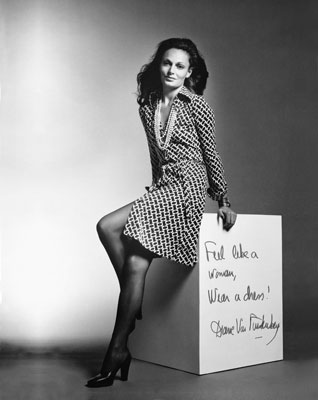
A fashion fairy tale, a marketing master class
Following conversations this week with a client who was wearing a wrap dress, and a colleague who was surprised at what he thought was my sudden interest in fashion, I thought I ought to write the story I talked to them about…
A fashion fairy tale, a marketing master class
The Diane von Fürstenberg story is a fashion fairy tale and an interesting lesson in branding.
The fashion narrative runs something like this; a beautiful, free-spirited, young, European princess arrives in New York in the early 1970s and makes her fortune, is pictured on the cover of Newsweek before she is 30, but then loses her way in business. She moves to Paris, gets divorced and then remarried thereby losing her entitlement to use the title Princess.
Then in her 50s she stages a comeback and is now running a business that is more successful than ever, with 85 stores worldwide as well as working for numerous women’s causes. She is on the board of Vital Voices, a global organisation to support female leaders.
The lesson in branding begins in her childhood. Looking back she once told Oprah Winfrey that as a little girl she “didn’t know what I wanted to do, but I knew the kind of woman I wanted to be – an independent woman, who drives her own cars and pays her own bills”.
Then in in 1970, with a $30,000 investment, she began designing women’s clothes; “The minute I knew I was about to be Egon’s (that’s Prince Egon of Fürstenberg ‘s) wife, I decided to have a career. I wanted to be someone of my own, and not just a plain little girl who got married beyond her desserts.”
Shortly afterwards she met with the then Vogue editor, Diana Vreeland, who declared her designs “absolutely smashing” and so had her name listed on the Fashion Calendar for New York Fashion Week, a vital stepping stone in building her brand.
However at the core of her brand and the fashion narrative is THE dress.
Dubbed “The Most Empowering Dress Ever” by Marie Claire in 2014, 40 years after its launch, it was a wrap over dress made of jersey without buttons or zips.
Her insight into its design came from her own observations, not formal market research, as she explained in her 1998 autobiography, Diane, A Signature Life; “I had no focus groups, no marketing surveys, no plan. All I had was an instinct that women wanted a fashion option besides hippie clothes, bell-bottoms and stiff pantsuits that hid their femininity… The dresses made sense. They were sexy and practical. There were very few businesswomen at the time, and the few in management tended to play down their gender by dressing more like men than like women”
“It allowed women to go to work and still feel like a woman. I scribbled a little something on a white cube in one of my first ads and it is still true today: ‘Feel like a woman, wear a dress.’ Your most authentic self is always your most powerful self.’”
The choice of material was a very conscious one. Asked to explain it she noted that it is female designers – “Coco Chanel, Donna Karan, me” – who dress women in jersey, “because we know it feels great and lets you get on with your day, and we care about that.”
When asked about its undeniable sex appeal she famously replied; “Well, if you’re trying to slip out without waking a sleeping man, zips are a nightmare.”
It was, and indeed still is, a dress for women who choose clothes for freedom, movement and self-determination. “That’s what my brand does,” she says. “We sell confidence.” And that confidence comes from the combination of comfort and glamour.
The concept of a wrap design wasn’t something new; it’s a technique which probably pre-dates sewing and is how women still wear their clothes in many parts of the world. Dior had translated the idea into high fashion in the Sixties but what made the von Fürstenberg dress was the cut, the cloth and the neckline – it was pretty, practical and, if required, provocative.
Within two years she’d sold five million dresses and was featured on the cover of Newsweek. The cover was intended to be Gerald Ford, who had just won his first Republican Presidential Primary, but was changed at the last minute. The accompanying article declared her “the most marketable woman since Coco Chanel.”
Talking to The Guardian newspaper recently she admitted that she often “took that dress for granted, even though it paid my bills, paid for my children’s education, my apartment on Fifth Avenue and my house in the country. To be honest, sometimes I even resented it. But now, finally, I see: this dress is actually bigger than me. I am just a conduit for the dress. … It is so much the essence of my brand. I became who I am, because of that dress, because the dress is everything my brand stands for.”